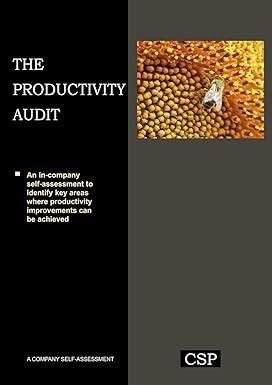Question
1) Tetra Company purchased 2,000 units of inventory that cost $4.00 each on January 1, 2016. An additional 3,000 units of inventory were purchased on
1) Tetra Company purchased 2,000 units of inventory that cost $4.00 each on January 1, 2016. An additional 3,000 units of inventory were purchased on January 12, 2016 at a cost of $4.20 each. Tetra Company sold 4,000 units of inventory on January 20, 2016. Which of the following entries would be required to recognize the cost of goods sold assuming that Tetra Co. uses the perpetual inventory method and a FIFO cost flow method?
a)
| Inventory | 16,400 | |
| Cost of goods sold | 16,400 |
b)
| Cost of goods sold | 16,600 | |
| Inventory | 16,600 |
c)
| Cost of goods sold | 16,400 | |
| Inventory | 16,400 |
d)
| Inventory | 16,600 | |
| Cost of goods sold | 16,600 |
2) If a firm is using the lower-of-cost-or-market rule and if a write-down entry is required, which of the following effects will apply?
a) Net income will increase.
b) Gross margin will decrease.
c) Assets will decrease.
d) Gross margin will decrease and assets will also decrease.
| 3) Anton Co. uses the perpetual inventory method. Anton purchased 680 units of inventory that cost $8 each. At a later date the company purchased an additional 810 units of inventory that cost $10 each. If Anton uses the FIFO cost flow method and sells 1,050 units of inventory, the amount of cost of goods sold will be: |
a) $10,500.
b) $9,140.
c) $8,400.
d) $10,580.
4)
| The inventory records for Radford Co. reflected the following |
| Beginning Inventory @ May 1 | 1,400 units @ $4.40 |
| First Purchase @ May 7 | 1,500 units @ $4.60 |
| Second Purchase @ May 17 | 1,700 units @ $4.70 |
| Third Purchase @ May 23 | 1,300 units @ $4.80 |
| Sales @ May 31 | 4,500 units @ $6.30 |
Answer the following:
| i) Determine the weighted average cost per unit (rounded) for May. |
a) $4.63
b) $4.57
c) $4.70
d) $6.30
ii) Determine the amount of cost of goods sold assuming the LIFO cost flow method.
a) $21,600
b) $21,130
c) $20,700
d) $19,800
iii) Determine the amount of ending inventory assuming the FIFO cost flow method.
a) $6,720
b) $6,710
c) $6,160
d) $5,060
Step by Step Solution
There are 3 Steps involved in it
Step: 1

Get Instant Access to Expert-Tailored Solutions
See step-by-step solutions with expert insights and AI powered tools for academic success
Step: 2

Step: 3

Ace Your Homework with AI
Get the answers you need in no time with our AI-driven, step-by-step assistance
Get Started


